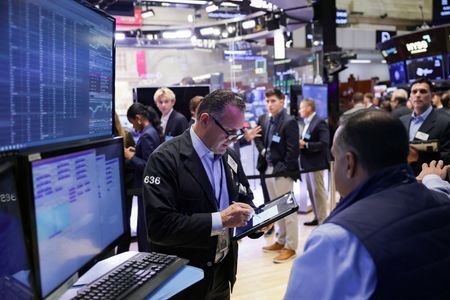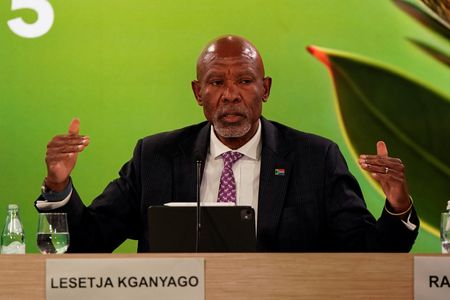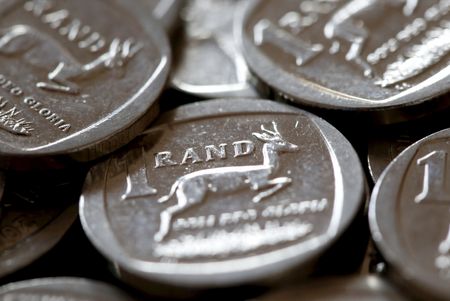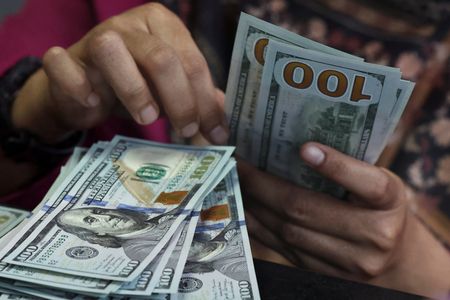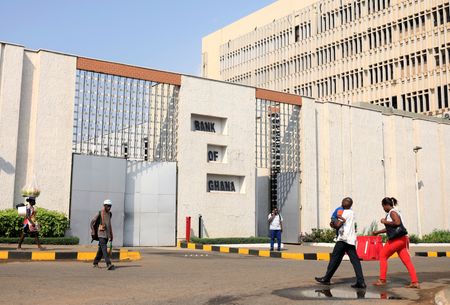By Stephen Culp
NEW YORK (Reuters) -Wall Street stocks ended lower while gold prices surged on Thursday as declining financial shares and simmering trade tensions between the United States and China dampened investor enthusiasm.
All three major U.S. stock indexes reversed earlier gains to end the session in negative territory while safe-haven investors continued to send gold to new highs.
Disappointing results from Travelers and the disclosure by Zions Bancorp that it would take a $50 million loss in the third quarter pulled the financial index down 2.75%.
“In the absence of data, the banks are going to be providing the sort of data substitute,” said Chuck Carlson, chief executive officer at Horizon Investment Services in Hammond, Indiana. “We’re seeing hefty declines in some of these banks and financials that are especially credit sensitive, so maybe credit quality is deteriorating.”
“The dollar’s pretty weak today, and crypto’s getting killed, too,” Carlson added. “It’s a risk-off day.
Signs of a dampening labor market appear to be making the case for easing monetary policy. Federal Reserve Governor Christopher Waller said on Thursday that “based on all the data we have … I believe that (the Fed) should reduce the policy rate another 25 basis points” at the conclusion of this month’s monetary policy meeting on October 29.
Investors were eying the latest developments in the escalating U.S.-China trade dispute. Top U.S. trade officials condemned China’s expansion of export controls on rare earths, while Beijing accused Washington of stoking global panic over supply chain disruption.
Trade uncertainty is one driver helping to launch gold prices to all-time highs, according to Sam Stovall, chief investment strategist of CFRA Research in New York.
“Because of the trade tensions, a lot of central banks, global central banks are buying gold and that is being helped by lower interest rates as well as the weakening U.S. dollar,” Stovall said. “It’s not a reaction to worries about the global economy, but rather political uncertainty.”
The Dow Jones Industrial Average fell 301.07 points, or 0.65%, to 45,952.24, the S&P 500 fell 41.98 points, or 0.63%, to 6,629.08 and the Nasdaq Composite fell 107.54 points, or 0.47%, to 22,562.54.
European stocks advanced as investors took largely upbeat corporate earnings to heart amid easing political tensions after French Prime Minister Sebastien Lecornu survived a confidence vote. French blue-chip shares advanced 1.4%.
MSCI’s gauge of stocks across the globe fell 0.93 points, or 0.10%, to 984.48.
The pan-European STOXX 600 index rose 0.69%, while Europe’s broad FTSEurofirst 300 index rose 15.27 points, or 0.68%.
The dollar edged lower against the euro and the yen as market participants watched tariff negotiations and parsed dovish comments from Federal Reserve officials.
The dollar index, which measures the greenback against a basket of currencies including the yen and the euro, fell 0.33% to 98.35, with the euro up 0.36% at $1.1688.
Against the Japanese yen, the dollar weakened 0.43% to 150.39.
Treasury yields dropped with the yield on the two-year note hitting its lowest level in more than three years amid trade concerns and credit market worries.
The yield on benchmark U.S. 10-year notes fell 6.9 basis points to 3.976%, from 4.045% late on Wednesday.
The 30-year bond yield fell 5 basis points to 4.5891% from 4.639% late on Wednesday.
The 2-year note yield, which typically moves in step with interest rate expectations for the Federal Reserve, fell 8.4 basis points to 3.422%, from 3.506% late on Wednesday.
Oil prices turned lower, weighed down by concerns over softening demand as investors dismissed supply issues arising after U.S. President Donald Trump said India’s Prime Minister Narendra Modi pledged to halt Russian oil imports.
U.S. crude dropped 1.39% to settle at $57.46 a barrel, while Brent settled at $61.06 per barrel, down 1.37% on the day.
Gold breached the $4,300 mark for the first time as the precious metal benefited from trade tensions and the U.S. government shutdown.
Spot gold rose 2.4% to $4,308.51 an ounce. U.S. gold futures rose 2.95% to $4,300.00 an ounce.
(Reporting by Stephen Culp; Additional reporting by Marc Jones in London and Kevin Buckland in Tokyo; Editing by Nick Zieminski, Cynthia Osterman and Edmund Klamann)

